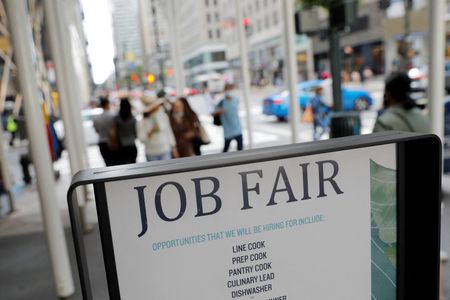By Lucia Mutikani
WASHINGTON (Reuters) – The number of Americans filing new claims for unemployment benefits fell more than expected last week, but that likely does not change the view that the labor market is gradually slowing as higher interest rates cool demand in the economy.
Though the weekly jobless claims report from the Labor Department on Wednesday also showed unemployment rolls declining for the first-time since mid-September, they remained near the highs for this year. The drop in both initial and continuing claims likely reflected ongoing challenges ironing out seasonal fluctuations from the data.
Slowing demand for labor and subsiding inflation have led economists and financial markets to conclude the Federal Reserve was done hiking interest rates in the current cycle.
“Looking past seasonal noise, we think the claims data are consistent with a job market that is cooling enough to keep rate hikes off the table, but too strong to make rate cuts a consideration any time soon,” said Nancy Vanden Houten, lead U.S. economist at Oxford Economics in New York.
Initial claims for state unemployment benefits dropped 24,000 to a seasonally adjusted 209,000 for the week ended Nov. 18. The decline more than reversed the jump in the prior week, which had lifted claims to a three-month high. Economists polled by Reuters had forecast 226,000 claims for the latest week.
The data was released a day early because of the Thanksgiving holiday on Thursday.
Unadjusted claims rose 21,239 to 238,677 last week. Claims in California surged 7,911. There were also significant increases in filings in Kentucky, Oregon, Kentucky and Illinois. Only Texas reported a decrease in claims in excess of 1,000.
Minutes of the Fed’s Oct. 31-Nov. 1 meeting published on Tuesday showed that while policymakers viewed labor market conditions as having “remained tight,” they noted that “they had eased since earlier in the year, partly as a result of recent increases in labor supply.”
Stocks on Wall Street were trading higher. The dollar rose against a basket of currencies. Prices of shorter-dated U.S. Treasuries fell.
LABOR MARKET SLOWING
Financial markets are anticipating a rate cut in the middle of 2024, according to CME Group’s FedWatch Tool. Most economists, however, view a rate cut as premature.
Indeed, a survey from the University of Michigan on Wednesday showed consumers this month anticipating higher inflation both in the near and long term. The rise in inflation expectations, especially over the next five years to the highest level since 2011, could worry policymakers. Since March 2022, the U.S. central bank has hiked its policy rate by 525 basis points to the current 5.25%-5.50% range.
“This will remind policymakers that it will be some time before the Fed can consider the 2021-22 surge in inflation to have truly been contained and reversed,” said Conrad DeQuadros, senior economic advisor at Brean Capital in New York.
But other economists were not too concerned, with Daniel Silver, an economist at JPMorgan, arguing that “we should also keep in mind that this increase in inflation expectations has not been evident to the same degree in some other related measures.”
A survey from the New York Fed this month showed softer inflation expectations in October.
The claims data covered the period during which the government surveyed businesses for the nonfarm payrolls component of November’s employment report.
Claims rose marginally between the October and November survey weeks. The economy created 150,000 jobs in October.
Though the labor market is steadily slowing, there are signs the moderation is broadening out. According to the Bank of America Institute, an analysis of internal data showed a rise in “pay disruptions” over 2023, consistent with rising joblessness.
It noted that this phenomenon, previously confined to higher-income groups, appeared to be extending to middle- and lower-income cohorts. The institute also said there was a significant slowdown in job-to-job moves, consistent with slower hiring and workers’ reluctance to move against an uncertain economic backdrop.
Data next week on the number of people receiving benefits after an initial week of aid, a proxy for hiring, will offer more clues on the health of the labor market in November. Continuing claims fell 22,000 to 1.840 million during the week ending Nov. 11, the latest claims report showed. They had increased since mid-September, hitting a two-year high in early November.
Most economists expect them to resume their upward trend in the coming weeks. A combination of easing labor market conditions and difficulties adjusting the data for seasonal fluctuations following an unprecedented surge in applications for jobless benefits early in the COVID-19 pandemic have pushed continuing claims higher.
Slowing economic demand was evident in a report from the Commerce Department on Wednesday showing business spending on equipment struggling to rebound early in the fourth quarter. Non-defense capital goods orders excluding aircraft, a closely watched proxy for business spending plans, dipped 0.1% last month after falling 0.2% in September, the Commerce Department’s Census Bureau said.
Core capital goods shipments were unchanged for a second straight month. Shipments of non-defense capital goods dropped 0.3% following a 0.2% decline in the prior month.
These shipments feed into the calculation of equipment spending in the gross domestic product report. Business spending on equipment contracted in the third quarter. The economy grew at a 4.9% annualized rate in the July-September quarter. Growth estimates for the fourth quarter are mostly below a 2% pace.
“It’s true that the recent drop-back in bond yields may provide some support for investment, but borrowing costs are likely to remain considerably higher than they were a couple of years ago for the foreseeable future,” said Andrew Hunter, deputy chief U.S. economist at Capital Economics. “And with banks continuing to tighten lending standards too, there appears to be little chance of an imminent recovery.”
(Reporting by Lucia Mutikani; Editing by Chizu Nomiyama and Paul Simao)
